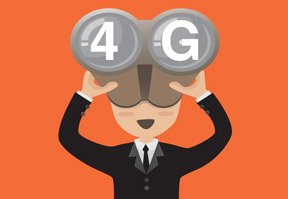KORE’s Alex Brisbourne says that the M2M industry has been too focused recently on changes in connectivity technology, particularly from 2G to 3G and 4G. But in this interview with Robin Duke-Woolley of Beecham Research, Brisbourne insists we should be more focused on the factors causing these changes and on the opportunities they bring.
Robin Duke-Woolley, Beecham Research: What are the key changes you see in the market right now for adopters of M2M?

Alex Brisbourne, KORE: Let’s take technology first. On the one hand our customers are deciding on the practical challenges of the right connectivity technologies, and on the other the enabling technologies available to them at the device level to be able to more easily and more rapidly build products from scratch.
To date the industry at the connectivity level has been a 2G industry. At the device level, it has been somewhat proprietary. Both of these are changing. The road to 3G and 4G technology isbecoming ever clearer for everybody and, in fact, the substantial investments and improvements on 4G/LTE in particular and into carrier roaming are really starting to make that look viable in the quite near term for the broad base of M2M applications.
Customers are starting to recognise the opportunity to make their applications substantially richer as a result of: the latency reduction, the improved performance, the improved reliability of the 3G/4G networks and
the economics of it.
Over the last 10-plus years the art form has been to minimise the use of and reliance on the network. The fact that the cellular network is changing from 2G to 3G to 4G is presenting an opportunity for our customers to really make applications that have a high value quotient by making them richer.
The reach of the devices is becoming more ubiquitous as you go from 3G to 4G, so the relatively small additional cost of the device for most applications – but not all – is no longer a significant impediment. If you can monetise another few dollars a month more in a richer device and application set, you are recovering your small overhead costs for the device very quickly indeed.
Of course, adopters have been forced to go to 3G and 4G in North America rather more quickly than they first expected, so the market for richer applications is not quite there yet. We expect it to be much clearer in a couple of years’ time.

RDW: So, moving from 2G to 3G and 4G and the enforcing of that may be helping to develop the market, rather than causing a problem?
AB: Yes, I think so. Inevitably, there is always a group that believe you have got to be incredibly slim, and cheap. And there are niches in the market for which that is a valid consideration. But not everyone is in that camp.
In general terms we have the same trend developing as we saw with the internet. If you have access to faster, cheaper data pipes then people will find ways to enrich and differentiate their offerings and applications.
RDW: An interesting observation. Over the last few years we in the M2M industry have been talking more about the cost implications of the change and that it risks slowing down the market. But what you’re saying is – yes, it is forcing a change. It’s making people think about what they could now do because they did not have that flexibility before. So we should perhaps view this as a potential step change in the market towards thinking about the applications they could now have. Forcing the change is helping to develop the market – and that’s a good thing?
AB: That’s a good way of summarising it. An additional point here is that those apps are being made richer in the US and this is percolating into other marketplaces very quickly. I would say that it is quite unusual now for us to be seeing new devices coming to market in Europe or in Asia that are not built as 3G-centric (or in some cases 4G-centric) devices.
Another key change is that as a result of the complicated M2M ecosystem, the industry has largely been dominated by integrated application service providers for about 10-15 years, who have been selling discrete solutions to enterprises.
In the past 18 months we have been seeing a strong move towards enterprise-driven initiatives where they want to take ownership of their own destiny. This is partly for cost reasons and partly because they want to own and control their own data. So the larger scale deployments are starting to be driven by enterprises – even the enterprises that have gone the ASP route for discrete applications in the early phases.
That brings us to the next part, which is the role of platforms, technology management and the increasing need to have integration of M2M data into enterprise level services.
RDW: What does that mean for KORE?
AB: The main point is globalisation. More than 80% of our top 50 customers use more than one service offering from KORE: different technologies, different regions or a mix. When people were using micro amounts of data, the issues were easier to deal with.
Once you start running tens or even hundreds of megabytes of data within certain places, it is increasingly critical that you have in-region placement of services. The economics do not work otherwise. Providing 5GB of data in 11 European marketplaces is challenging.
RDW: Looking to the future, what do you think differentiates KORE?
AB: We remain highly committed to the critical importance of high reliability, managed connectivity and slavishly focused on building the best possible durable connectivity hub for our customers, bringing durable networks to national marketplaces. That remains our main focus.
AB: We remain highly committed to the critical importance of high reliability, managed connectivity and slavishly focused on building the best possible durable connectivity hub for our customers, bringing durable networks to national marketplaces. That remains our main focus.
We are continuing to infill our global map, where we look to new markets that our customers want us to provide services into. We are strengthening carrier activities more broadly in Europe and in Asia, and leveraging the more recent positions of broader satellite services in conjunction with Inmarsat. There is a lot of focus inevitably in the North American marketplace right now in reviewing with customers the technology changes underway.
KORE is the only company that can provide a complete and unbiased family of connectivity solutions for 2G, 3G and 4G data rates across GSM, CDMA and satellite networks. There is no alternative that is not available to those customers needing to make changes and we are investing a great deal of money in helping advise customers and helping define their direction. To do with lifecycle, their usage, their business plans and so on – providing advice in the most appropriate way.
We do sweat the detail, and we don’t have a particular pony that we have to whip into action. We match the needs of the customer.










